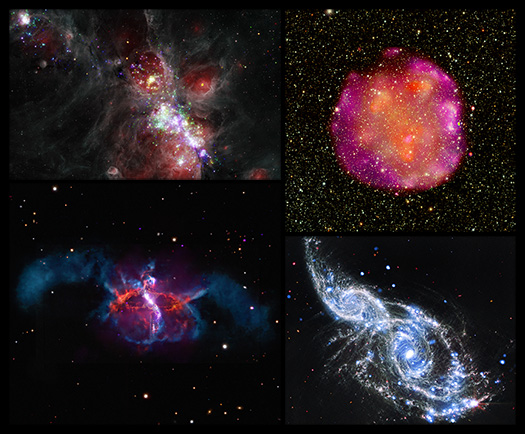Normal Galaxies & Starburst Galaxies
Fall Collection: Before Fall Leaves, See Seasonal Offerings from NASA's Chandra
Before fall gives way to winter in the northern hemisphere, NASA’s Chandra X-ray Observatory has several images that celebrate autumn and its many delights to share. In spirit of the season, this collection gathers Chandra data with those from its telescopic family including NASA’s James Webb, Hubble, and Spitzer Space Telescopes, plus others in space and on the ground.
Black Holes Can Cook for Themselves
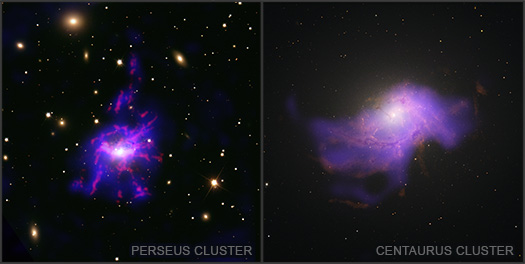
30 The Perseus & Centaurus Galaxy Clusters
Credit: Perseus: X-ray: NASA/CXC/SAO/V. Olivares et al.; Optical/IR: DSS; H-alpha: CFHT/SITELLE; Image Processing: NASA/CXC/SAO/N. Wolk; Centaurus: X-ray: NASA/CXC/SAO/V. Olivaresi et al.; Optical/IR: NASA/ESA/STScI; H-alpha: ESO/VLT/MUSE; Image Processing: NASA/CXC/SAO/N. Wolk
Astronomers have taken a crucial step in showing that the most massive black holes in the universe can create their own meals. Data from NASA’s Chandra X-ray Observatory and the Very Large Telescope (VLT) provide new evidence that outbursts from black holes can help cool down gas to feed themselves.
This study was based on observations of seven clusters of galaxies. The centers of galaxy clusters contain the universe’s most massive galaxies, which harbor huge black holes with masses ranging from millions to tens of billions of times that of the Sun. Jets from these black holes are driven by the black holes feasting on gas.
NASA's Chandra Finds Galaxy Cluster That Crosses the Streams
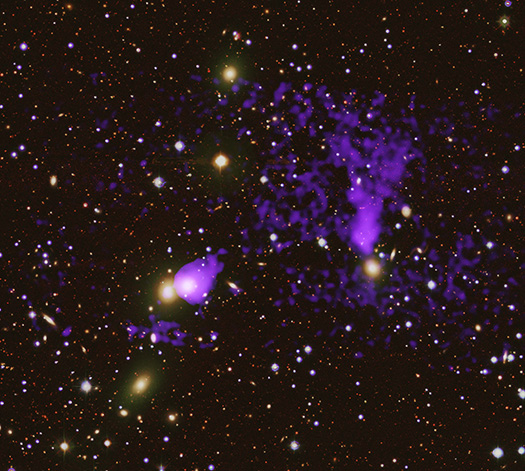
Zwicky 8338
Credit: X-ray: NASA/CXC/Xiamen Univ./C. Ge; Optical: DESI collaboration; Image Processing: NASA/CXC/SAO/N. Wolk
Astronomers using NASA’s Chandra X-ray Observatory have found a galaxy cluster has two streams of superheated gas crossing one another. This result shows that crossing the streams may lead to the creation of new structure.
Researchers have discovered an enormous, comet-like tail of hot gas — spanning over 1.6 million light-years long — trailing behind a galaxy within the galaxy cluster called Zwicky 8338 (Z8338 for short). This tail, spawned as the galaxy had some of its gas stripped off by the hot gas it is hurtling through, has split into two streams.
This is the second pair of tails trailing behind a galaxy in this system. Previously, astronomers discovered a shorter pair of tails from a different galaxy near this latest one. This newer and longer set of tails was only seen because of a deeper observation with Chandra that revealed the fainter X-rays.
Chandra Teams Up Again With Astrophotographers
Messier 106 (M106), also known as NGC 4258, is a spiral galaxy – like our own Milky Way -- located in the constellation Canes Venatici. It lies at a distance of roughly 23 million light-years and spans some 135,000 light-years in diameter.
This galaxy is famous, however, for something that our Galaxy doesn’t have – two extra spiral arms that glow in X-ray, optical, and radio light. These features, called anomalous arms, are not aligned with the plane of the galaxy, but instead intersect with it. The X-ray image from Chandra reveals huge bubbles of hot gas above and below the plane of the galaxy. These bubbles indicate that much of the gas that was originally in the disk of the galaxy has been heated to millions of degrees and ejected into the outer regions by the jets from a supermassive black hole at the galaxy’s core.
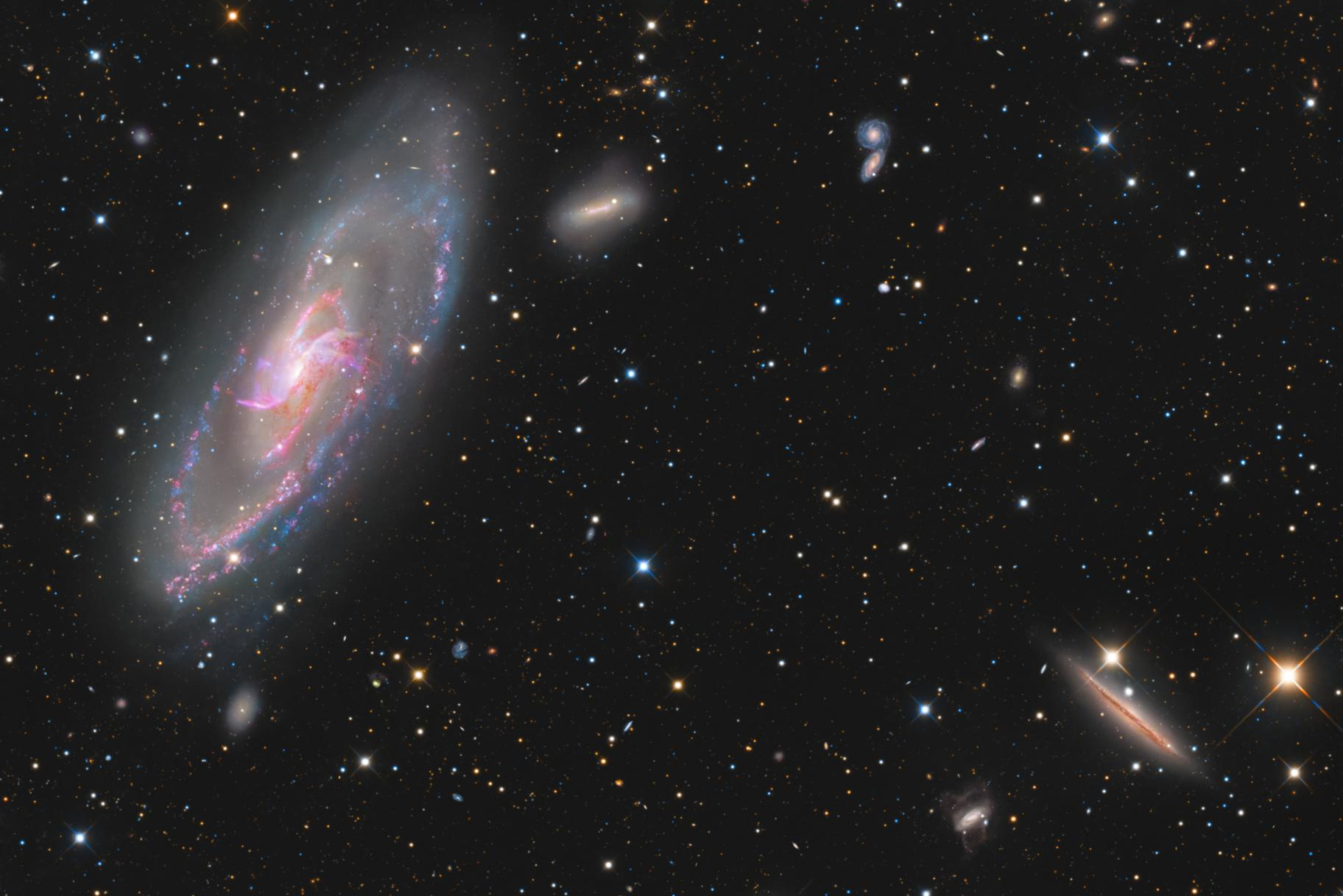
Credit: Optical: Deep Sky Collective; Chandra X-ray (purple): NASA/CXC/SAO;
VLA Radio (yellow): NSF/NRAO/VLA; Spitzer IR (Red): NASA/JPL-Caltech
It's not only space-based X-ray telescopes like Chandra, however, that have looked at M106. Excellent work has been done from the ground including by amateur astrophotographers including a group called the Deep Sky Collective (DSC). The DSC, founded by Tim Schaeffer in 2023, aims to use the group’s telescopes in a concerted way to explore some of the faintest and most difficult target in the sky in great detail.
New NASA Sonifications Listen to the Universe's Past
Your browser does not support the video tag.
Cassiopeia A Sonification
Credit: X-ray: NASA/CXC/SAO; Optical: NASA/ESA/STScI; IR: NASA/ESA/CSA/STScI/Milisavljevic et al., NASA/JPL/CalTech; Image Processing: NASA/CXC/SAO/J. Schmidt and K. Arcand; Sonification: NASA/CXC/SAO/K.Arcand, SYSTEM Sounds (M. Russo, A. Santaguida)
A quarter of a century ago, NASA released the “first light” images from the agency’s Chandra X-ray Observatory. This introduction to the world of Chandra’s high-resolution X-ray imaging capabilities included an unprecedented view of Cassiopeia A, the remains of an exploded star located about 11,000 light-years from Earth. Over the years, Chandra’s views of Cassiopeia A have become some of the telescope’s best-known images.
To mark the anniversary of this milestone, new sonifications of three images — including Cassiopeia A (Cas A) — are being released. Sonification is a process that translates astronomical data into sound, similar to how digital data are more routinely turned into images. This translation process preserves the science of the data from its original digital state but provides an alternative pathway to experiencing the data.
Astronomers Find Spark of Star Birth Across Billions of Years
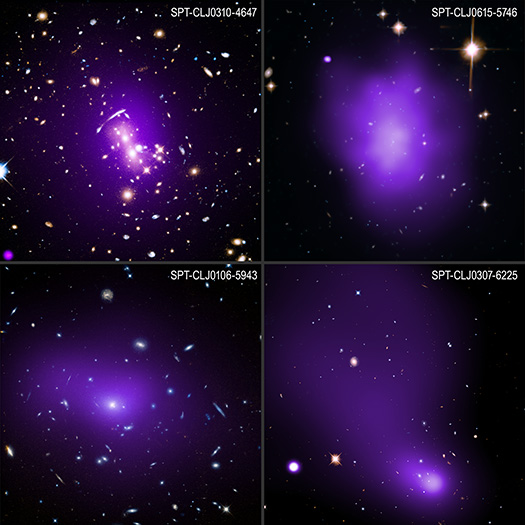
Brightest Cluster Galaxies Survey
Credit: X-ray: NASA/CXC/MIT/M. Calzadilla el al.; Optical: NASA/ESA/STScI;
Image Processing: NASA/CXC/SAO/N. Wolk & J. Major
These four images represent a sample of galaxy clusters that are part of the largest and most complete study to learn what triggers stars to form in the universe’s biggest galaxies, as described in our latest press release. This research, made using NASA’s Chandra X-ray Observatory and other telescopes, showed that the conditions for stellar conception in these exceptionally massive galaxies have not changed over the last ten billion years.
Galaxy clusters are the largest objects in the universe held together by gravity and contain huge amounts of hot gas seen in X-rays. This hot gas weighs several times the total mass of all the stars in all the hundreds of galaxies typically found in galaxy clusters. In the four galaxy cluster images in this graphic, X-rays from hot gas detected by Chandra are in purple and optical data from NASA’s Hubble Space Telescope, mostly showing galaxies in the clusters, are yellow and cyan.
Exploring Stephan's Quintet with Multiple Senses
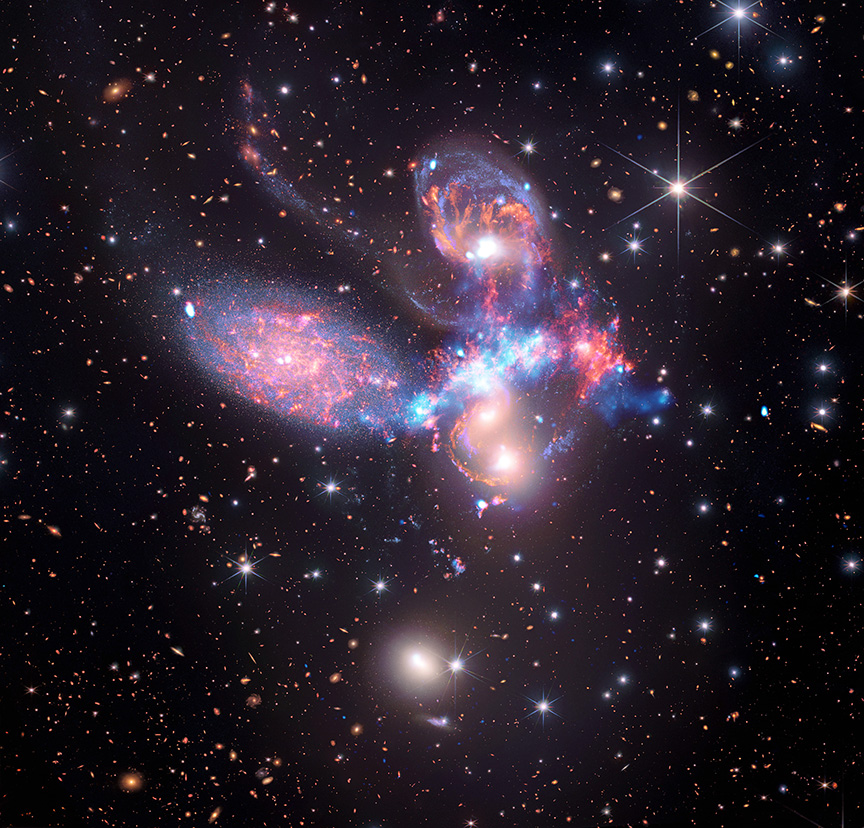
Stephan's Quintet
Credit: X-ray: NASA/CXC/SAO; IR (Spitzer): NASA/JPL-Caltech; IR (Webb): NASA/ESA/CSA/STScI
Summary
Experts created two new visual and auditory experiences to explore the complexity and beauty of a compact galaxy group known as Stephan’s Quintet. The guided three-dimensional visualization surveys the galaxies — their structures, characteristics, and interactions — captured in multiple wavelengths of light by some of NASA’s great observatories. The sonifications scan two-dimensional images of the quintet, translating the data into sound to reveal the depth and richness this intricate environment holds.
Using data gathered by NASA’s Hubble Space Telescope, Spitzer Space Telescope, Chandra X-ray Observatory, and James Webb Space Telescope, astronomers and visualization specialists from across several institutions came together to create two new unique sensory experiences of a compact group of galaxies known as Stephan’s Quintet: a video guiding viewers through a three-dimensional visualization of the galaxies, and audio tracks based on two-dimensional observation images. These add to the previously-developed multi-wavelength images, large tactile/audio display table, and small tactile images, bolstering the overall sensory experience of Stephan’s Quintet.
Galaxies Go on a Deep Dive and Leave Fiery Tail Behind
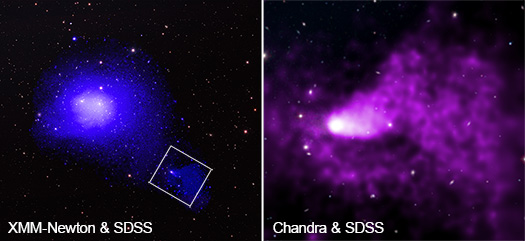
NGC 4839
Credit: X-ray: Chandra: NASA/SAO/Univ. of Alabama/M. S. Mirakhor et al.; XMM: ESA/XMM-Newton;
Optical: SDSS; Image processing: N. Wolk
A group of galaxies is plunging into the Coma galaxy cluster and leaving behind an enormous tail of superheated gas. Astronomers have confirmed this is the longest known tail behind a galaxy group and used it to gain a deeper understanding of how galaxy clusters – some of the largest structures in the universe – grow to their enormous sizes.
NASA's Chandra, Webb Combine for Arresting Views
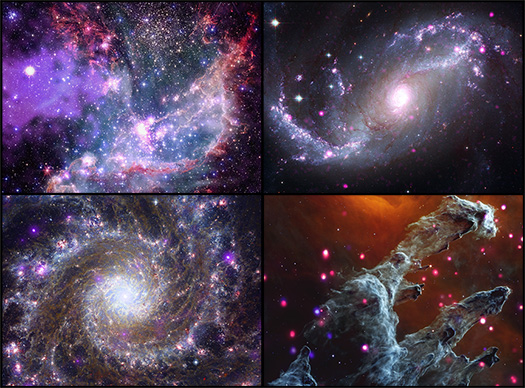
NGC 346, NGC 1672, M74 & M16
Credit: X-ray: Chandra: NASA/CXC/SAO, XMM: ESA/XMM-Newton; IR: JWST: NASA/ESA/CSA/STScI, Spitzer: NASA/JPL/CalTech; Optical: Hubble: NASA/ESA/STScI, ESO; Image Processing: L. Frattare, J. Major, N. Wolk, and K. Arcand
Four composite images deliver dazzling views from NASA's Chandra X-ray Observatory and James Webb Space Telescope of two galaxies, a nebula, and a star cluster. Each image combines Chandra's X-rays — a form of high-energy light — with infrared data from previously released Webb images, both of which are invisible to the unaided eye. Data from NASA's Hubble Space Telescope (optical light) and retired Spitzer Space Telescope (infrared), plus the European Space Agency's XMM-Newton (X-ray) and the European Southern Observatory's New Technology Telescope (optical) is also used. These cosmic wonders and details are made available by mapping the data to colors that humans can perceive.
Chandra Determines What Makes a Galaxy's Wind Blow

NGC 253
Credit: X-ray: NASA/CXC/The Ohio State Univ/S. Lopez et al.; H-alpha and Optical: NSF/NOIRLab/AURA/KPNO/CTIO; Infrared: NASA/JPL-Caltech/Spitzer/D. Dale et al; Full Field Optical: ESO/La Silla Observatory.
On Earth, wind can transport particles of dust and debris across the planet, with sand from the Sahara ending up in the Caribbean or volcanic ash from Iceland being deposited in Greenland. Wind can also have a big impact on the ecology and environment of a galaxy, just like on Earth, but on much larger and more dramatic scales.
A new study using NASA's Chandra X-ray Observatory shows the effects of powerful winds launched from the center of a nearby galaxy, NGC 253, located 11.4 million light-years from Earth. This galactic wind is composed of gas with temperatures of millions of degrees that glows in X-rays. An amount of hot gas equivalent to about two million Earth masses blows away from the galaxy's center every year.
NGC 253 is a spiral galaxy, making it similar to our Milky Way. However, stars are forming in NGC 253 about two to three times more quickly than in our home galaxy. Some of these young stars are massive and generate a wind by ferociously blowing gas from their surfaces. Even more powerful winds are unleashed when, later in their relatively short lives, these stars explode as supernovae, and hurl waves of material out into space.

